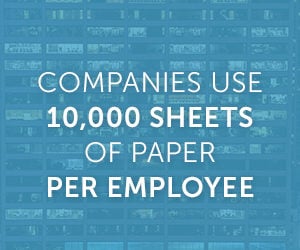
Work Instructions
3 min read
The True Cost of Paper-Based Documentation

Paper is viewed as a necessity in the workplace.
It is used for a variety of reasons, from travel documents to field service or product manuals to employee on-boarding and training handbooks. It’s become such a staple, companies don’t even think twice about the actual cost of these reams of paper ⎼ including quality issues and lost time ⎼ until now.
Paper Doesn’t Just Grow On Trees

Let’s start with the big one: cost.
At about $12.99 a ream (on average), it’s easy to brush off the annual dollar amount spent on paper. But this cost adds up.
According to one study, the average company uses about 10,000 sheets of paper (20 reams) per employee per year. $12.99 x 20 = $259.80. Multiply that by 50 employees, and you already get a pretty big number, $12,990 to be exact. Not only spent, but wasted.
Research has shown that up to 45% of this paper ends up in the trash, that's quite a bit of money that could be put back into the company. We have advanced in so many ways, so why, in this area, do we seem so behind?
Wasted Time Is Productivity Lost
Paper doesn’t only cost a lot to purchase - working with it can also create issues with accuracy and standardization. An employee on the shop floor or out in the field is far more likely to complete a procedure using tribal knowledge rather than searching through emails, manuals, or files to find the most up to date work instructions.
It is also very likely that updates in procedures may not reach everyone, leading to out of date documentation being used. This has the potential to lead to mistakes and standardization issues with even the most experienced employees, costing your company wasted money and time.
Formatting And Tracking Nightmares
 Updating paper-based processes can be extremely tedious and time consuming. Formatting documents in Microsoft Word and other platforms can be a nightmare; the addition of one table or photo can ruin an entire document and take hours to correct.
Updating paper-based processes can be extremely tedious and time consuming. Formatting documents in Microsoft Word and other platforms can be a nightmare; the addition of one table or photo can ruin an entire document and take hours to correct.
Combine formatting problems with manually tracking document changes and ensuring the correct versions are distributed to employees, and the hours start to add up.
This is time wasted. Time that could be better spent growing your business.
Topic(s):
Work Instructions
Related Posts
View All PostsEffective Ways To Reduce Employee Training Costs In Manufacturing
29 min read
If you have a business that includes the use of employees, one of the first and most important tasks you must fund is training. This is true of all industries, but companies...
Continue Reading
Training
Why Sharepoint Fails at Knowledge Management
5 min read
Many industrial businesses rely on generic document management tools, like Microsoft Sharepoint, to store and share files. As a document management strategy, this makes...
Continue Reading
Training
Best Practices On How To Retain Factory Workers
30 min read
Manufacturing companies rely on workers to be the frontline of production. And while companies across all sectors struggle to recover from a labor crisis perpetuated in part...
Continue Reading


